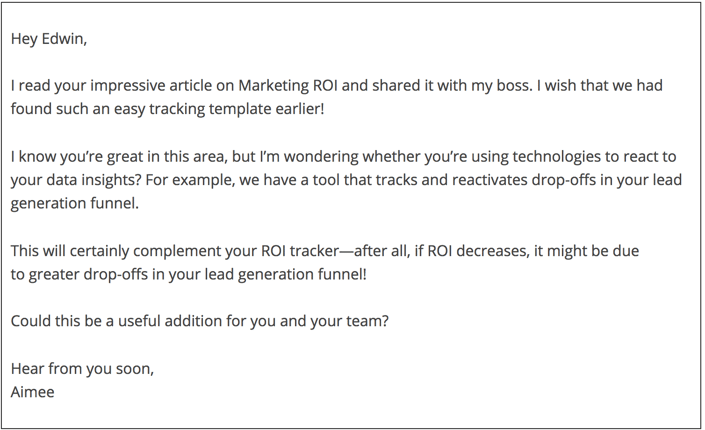

How to Save B2B Email Marketing from The Great Sales-Marketing Divide


My inbox is constantly flooded with emails. I guess it’s the same for most of you.
Many are long-winded, self-promoting, call-me-now emails from salespeople who somehow got hold of my email address. They trumpet their wares without a care for my concerns; topped with a self-serving call-me-now plea that asks me to call the salesperson.
The cheek of it. I guess it’s the same for most of you, too.
Why do salespeople send such—yawn—emails?
Email marketing has well-documented strategies and best practices. Salespeople have insights into their prospects’ cares and desires, yet these things are left out of their—yawn—emails.
And it’s all because of a divide.
The Great Sales-Marketing Divide
Maybe it’s jockeying for resources, battling for position and the boss’s ear, or operating in self-imposed bubbles, but there's always been friction between marketing and sales ever since they were split into their own departments. Much has been written about it (here, here, and here).
That’s a shame as each faction has complementary strengths—marketing crafts appealing content, sales knows prospect’s pains and journey. Mix, brew, and serve, and you’ll get an amazing drip email marketing campaign that serves you.
In fact, email marketing done well gives you two important benefits:
- It builds you—the sales person—as an impeccable resource for your prospect.
- It keeps you at the top of your prospect’s minds.
Which leads to this truth:
When your prospects need help, you’re the first one on their list to call."
Think about it. Let it sink in. Powerful, isn’t it?
You won’t need to chase your prospects—they’ll chase you instead, especially since your actions will fit their current behaviours of spending 80 percent of their time searching and living online. 
Closing the Divide
For the rest of this post, we’ll discuss tactics to close the sales and marketing schism for B2B email marketing campaigns. We'll also set our eyes on developing an amazing email sales strategy to nurture and close prospects.
1. Join the Brainstorm Sessions
Your time’s at a premium. You need to make calls, chase leads, and perform demos. So why spend time to brainstorm emails with the marketing department?
Being part of the planning process from the get-go will align sales and marketing expectations on the goals and methods. More importantly, both can share insights that can make your email marketing better.
After all, you know your prospects like the back of your hand. So bring that knowledge to the table, help your marketing colleagues understand what drives your customers, who to target, and where to reach them. They, in turn, will craft the most compelling and articulate messages to help close your prospects.
2. Get the Right Contact and Curate the Journey
Don’t piss off your prospects by sending them emails that aren’t meant for them or getting their responsibilities and roles wrong. Make a list of your prospects and ensure that it has the right names and the right roles—and then check it twice. After all, first impressions count in starting your conversation.
Every good drip email campaign is a journey that moves your prospect from knowing nothing to being aware of your business to evaluating you and partnering with you. It’s a long path full of roadblocks (such as points of resistance) and detours (such as concerns).
Help your marketing team understand how to address prospects’ concerns and points of resistance. Teach them how to effectively educate customers and showcase the benefits that your prospects care for.
Read: How to Write B2B Marketing Emails that Get You Leads
3: What’s in it For Me?
Here’s a good time to learn an awkward truth: Your prospects don’t care about you or your products. They only care about their problems and solving them.
While your products might be immensely beneficial, they won't be so useful if you can't articulate the benefits in their context.
So craft your emails such that it highlights how your products could solve their problem. If that’s not possible, please do not revert to type and throw the book at them—just focus on one benefit that they might care about. As with most things, less is more.
And that will be enough.
Read: The One Question That Matters to Your Target Audience
4. Establish Value First. Don’t Ask for a Call…Yet.
It’s frustrating to get asked for a call on a first email, particularly when I don’t know you. In fact, it’s likely to be seen as presumptuous, rude, and possibly arrogant.
We know what happens to rude people.
Stop asking to schedule a call in your first email, especially if you don’t know whether the prospect is in the market for your product or service. Instead, establish what you can do for your prospect. Create that conversation with conversation starters such as “Are you frustrated by…?”
Once you get a response, now that’s when you can ask for the call.
5. Mind Your Language. When in Doubt, Simplify
Lingo, jargon, and buzzwords are attention killers.
You’ve been speaking with your prospects. You’re probably in tune with how they say things, what they say and the meaning behind their lexicon.
Use that knowledge to help your marketing colleagues understand your prospect’s language to personalise their emails. They’ll be very appreciative of this effort.
A Better Email Example for You
I thought it’ll be great to walk the talk and show how it all works together. Otherwise, it’s just fluff. This email example is based on a fictional company with a fictional product, but the situation is always true.
Do you think this advice works in your industry? What other suggestions worked for you? If you had to reach out to a new prospect, what would you say?

Image sources and credits:
Header image: Suprijono Suharjoto @ Dreamstime
Body image: vinnstock @ DepositPhotos
More insights